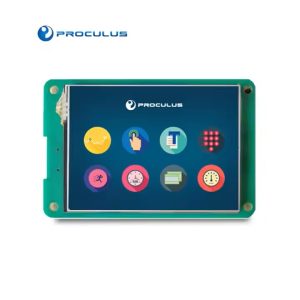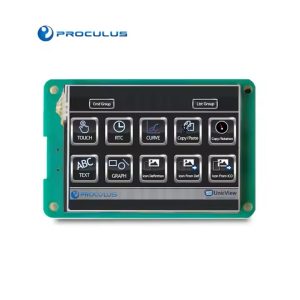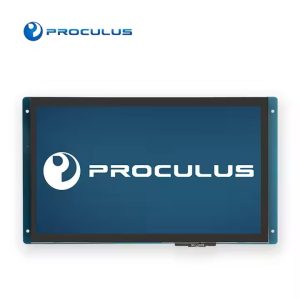What is TFT display? Applications and how to choose
To know what a TFT display is, it’s essential to understand its role in modern digital screens.
TFT technology is a key advancement in LCD displays, offering improved image quality, vibrant colors, and faster response times.
TFT displays provide reliable performance and high-definition visuals, and is found in everything from industrial control panels to consumer electronics
In this guide, we’ll explore what TFT displays are, how they function, their key applications, advantages, limitations, and how to choose the best one for your project.
 Selecting the right TFT display for your project requires careful consideration of several factors to ensure optimal performance and usability. Here are the key aspects to evaluate:
Selecting the right TFT display for your project requires careful consideration of several factors to ensure optimal performance and usability. Here are the key aspects to evaluate:
What is TFT display?
A TFT (Thin-Film Transistor) display is a type of LCD (Liquid Crystal Display) that uses a thin-film transistor array to control each individual pixel. This technology enables higher refresh rates, better contrast, and improved color accuracy compared to traditional passive-matrix LCDs. Each pixel in a TFT display is paired with its own transistor, allowing for more precise control over brightness and color representation. This results in sharper images, faster response times, and reduced motion blur, making TFT technology the preferred choice for applications that require detailed visuals and real-time data display.How does a TFT display work?
TFT displays operate using an active matrix system, where a thin-film transistor individually controls each pixel. This structure allows for faster response times and improved image stability compared to passive matrix LCDs. A TFT panel consists of several layers: A backlight, a liquid crystal layer, and a color filter, all working together to produce a high-quality image. When an electrical signal is applied, the liquid crystal molecules align in a way that modulates light passage, controlling brightness and color output. Since each pixel has its own dedicated transistor, TFT displays offer high-resolution visuals, reduced flickering, and superior refresh rates, making them ideal for applications that require precise image rendering and fast performance. Modern TFT displays can also incorporate advanced technologies like IPS (In-Plane Switching) for wider viewing angles and high-brightness panels for outdoor visibility.Main applications of TFT displays
TFT displays are used in a variety of industries, ranging from industrial automation to consumer electronics. Their ability to deliver high-quality visuals, reliable performance, and efficient power consumption makes them a preferred choice for many applications.Industrial Equipment H
TFT displays are essential interfaces for machinery, automation systems, and process control panels in industrial environments. Operators rely on these screens for real-time data visualization, system monitoring, and interactive controls. Key benefits include:- Rugged Design: Many industrial TFT displays are designed to withstand harsh conditions, including extreme temperatures, vibrations, and dust exposure;
- High Contrast & Readability: Essential for clear visibility in factories and outdoor environments;
- Customizable Interfaces: Supporting touch controls and programmable functions for automation systems.
Medical Devices
Medical equipment requires precise, high-resolution displays to ensure accurate diagnostics, monitoring, and control. TFT displays are commonly integrated into:- Patient Monitoring Systems: Vital signs, ECG readings, and other real-time health data visualization;
- Imaging & Diagnostic Equipment: Ultrasound, MRI, and X-ray systems depend on high-contrast, detailed displays for accurate readings;
- Portable Medical Devices: Compact and energy-efficient TFT screens are used in wearable and handheld diagnostic tools.
Consumer Electronics
TFT technology is at the core of today’s consumer devices, powering screens in smartphones, tablets, cameras, and gaming consoles. The reasons for its widespread adoption include:- High-Resolution Visuals: Essential for modern high-definition screens;
- Touchscreen Integration: Enabling intuitive user interactions;
- Fast Refresh Rates: Reducing motion blur for gaming and video playback.
Automotive Displays
Automotive manufacturers use TFT displays to enhance both functionality and aesthetics in vehicle interiors. Key applications include:- Digital Instrument Clusters: Replacing traditional analog gauges with customizable digital dashboards;
- Infotainment Systems: TFT touchscreens provide intuitive navigation, entertainment, and connectivity controls;
- Rear-View & Surround Cameras: High-brightness TFT displays ensure clear visibility in various lighting conditions.
Smart Home Devices
As smart home technology grows, TFT displays are becoming an integral part of home automation systems, providing users with seamless control over their connected devices. Common uses include:- Smart Thermostats: Enabling temperature adjustments with intuitive touch interfaces;
- Security & Access Systems: Displaying live camera feeds, door access controls, and alarm settings;
- Home Entertainment Controls: Touchscreen-based systems for managing lighting, audio, and appliances.
How to choose the best TFT display for your project?
 Selecting the right TFT display for your project requires careful consideration of several factors to ensure optimal performance and usability. Here are the key aspects to evaluate:
Selecting the right TFT display for your project requires careful consideration of several factors to ensure optimal performance and usability. Here are the key aspects to evaluate:
- Screen Size & Resolution: Consider the required screen dimensions and pixel density for clarity and user engagement. A higher resolution is critical for applications requiring sharp visuals, such as medical imaging and automotive dashboards;
- Communication Interface: Ensure compatibility with your system’s microcontroller or processor. Common interfaces include UART, SPI, I2C, and RGB. For projects requiring quick and easy integration, UART TFT displays provide a streamlined communication solution;
- Brightness & Contrast Ratio: If the display will be used in outdoor or high-ambient-light environments, opt for a high-brightness TFT panel to maintain visibility;
- Touchscreen Options: Choose between resistive touchscreens (ideal for industrial environments with glove usage) or capacitive touchscreens (preferred for consumer devices with multi-touch capabilities);
- Durability & Environmental Resistance: For applications exposed to dust, moisture, or extreme temperatures, select a ruggedized TFT display designed to handle harsh conditions.
- Power Consumption: Battery-operated devices benefit from low-power consumption TFT screens, ensuring extended operation without frequent recharging.
Find the Best UART TFT LCD Module for Your Needs
Need a high-quality, easy-to-integrate TFT display for your next project? Proculus Technologies offers advanced UART TFT LCD Modules designed for seamless communication, vibrant displays, and effortless user interface development. With intuitive software, robust hardware, and flexible customization options, Proculus displays help you accelerate product development while ensuring outstanding performance. Explore our range of products today and elevate your next project with high-performance visual interfaces!Conclusion
TFT displays have revolutionized digital interfaces with their superior image quality, fast response times, and broad range of applications. From industrial automation to consumer electronics, these displays deliver reliability and clarity in every use case. Choosing the right TFT display requires careful consideration of factors like screen size, resolution, interface compatibility, and environmental conditions. Whether you need a high-resolution display for a medical device or a rugged panel for industrial controls, the right selection ensures efficiency and longevity. With Proculus Technologies’ UART TFT LCD Modules, you gain access to cutting-edge display solutions tailored for ease of integration and exceptional performance.
Category:
Author:
Client:
Date:
PHP Code Snippets Powered By : XYZScripts.com
 English
English


